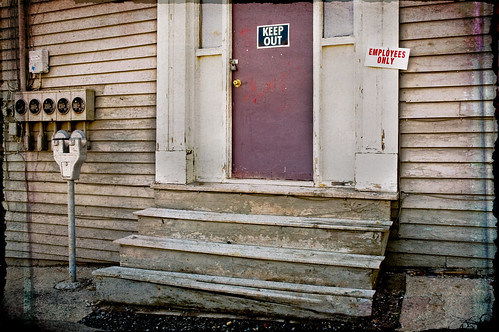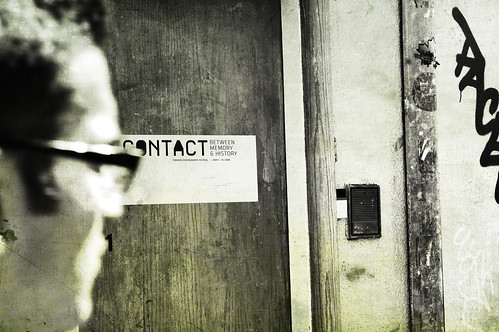
Last night at the grocery store, I happened to glance at the newspapers as I was leaving. The headline of the Guelph Mercury read, “Rags to Riches,” and I had a cynical moment of yeah whatever, thinking of the people at the drop-in centre. A familiar name floated in through my cynicism… I looked closer at the paper and stopped dead. Not only a familiar face, but a familiar photo. My photo! On the front page!
There was no photo credit; it said only “submitted photo.” The reproduction was lousy, and I wondered why, figuring it had been stolen off flickr. I reread the headline, and realized that it had been submitted by the man himself, Rick. It feels right that I didn’t get credit. It feels good that he liked the picture enough to share it with the paper, and it seems right that he doesn’t know my name. It wasn’t exactly how I hoped a photo of mine would get on the cover of a newspaper, but I’m pretty chuffed nonetheless.
I took his picture about a year ago, along with some others. The day I took that picture, I had this to say (which I later submitted to JPG Magazine and generated a somewhat heated exchange in the comments):
I have seen this man around town for years, asking for spare change in a gruff, slightly intimidating voice. Sometimes he seems a bit drunk, other times not, but he’s usually sitting on the sidewalk or a concrete planter.
For years I have avoided eye contact as I pass him, just gently shaking my head no and trying to make less jarring footfalls in the hopes that my loose change doesn’t jingle and give me away. I have never given him any change. Partly it’s because I carry my change in a change purse, so I don’t want to stand next to him while I awkwardly unzip the cranky zipper and finger through the loonies and toonie to fish out what I feel may be an appropriate coin; I didn’t want him to watch my selection.
(Not long ago, I read a mind-altering blog post about why you should give money to panhandlers, even if it could be supporting someone’s addiction. We all have damaging addictions, it’s just that some are more socially acceptable than others. Consider our addiction to gasoline and coffee and Walmart and goods manufactured by workers in appalling conditions… next to those addictions, is it really worth getting bent out of shape over fifty cents or a buck?
Now I am converted. As the author of that post said: “I give because someone in trouble is asking. I can’t be that attached to what they do with it once I do, because see, it’s a gift. I am offering a gift, perhaps under persuasion, but I am still offering it nonetheless.”)
Anyways, on this day he was sitting on the sidewalk outside a bar. I saw him sitting on this same corner the week before, the blue awnings and red railings echoing outwards from him like a wave, and I wanted to make a picture. But I was too afraid, so I just kept walking.
When I saw him there again, this time on the other side of the building’s corner, I couldn’t resist. I shot from across the street, and I think I saw him looking at me through the lens but figured I was just shooting the building or something.
As I went from shop to shop, shooting here and there, he stuck in my mind. I wanted more photos. I decided that I would ask for a picture if he was still there on my way home. Sometimes I get fatalistic in my photography, working my courage up to match the shot in my mind’s eye. I give myself time and figure if they’re still there, it was meant to be.
As I approached him, I couldn’t resist shooting a bit more, just in case he said no (ethics anyone?). As I shot, two pedestrians passed him by with barely a glance, one just outside the frame but indicated by the gesture of his hand holding the smoke. The passing bus changed the composition in a way I like.
Finally, I got up the courage to approach, loonie in my outstretched hand. He took it and said thanks. Then he immediately struck up a friendly conversation with my then 14-month-old son in the stroller, noting how healthy he looked, and I mentioned my son’s recent illness, and we talked for a bit. We had as nice a conversation as I’ve ever had with a random stranger, perhaps nicer because there was no unsolicited parenting advice.
I asked for his photo and he obliged happily. (It surprises me that almost no one asks why I want their photo… I wonder what they think of me and my camera?)
He said, “I’ll even give you a smile,” and he seemed downright joyful to me. Maybe it was just the contrast between my initial impression of him that’s been cemented in me for years and this friendly reality, but he seemed awfully pleased.
I left feeling like I had made a friend. The next day, on our way to the farmer’s market, we passed him, sitting a ways down the street from where he was before, but still directly on the concrete and with his crutches beside him. I made to smile at him, but he didn’t look at me; guess I was just another invisible passerby.
************
I saw him again a week later, and shot him outside the bank, but didn’t see him for many months. If you read his story, it turns out that he disappeared because shortly after I tok that picture, a police officer became friends with him and helped get him in touch with local services, like the Drop In Centre and housing.
This past January I started volunteering at the Drop In Centre on Sunday mornings. I kept hoping I would see the man so I could give him some prints, but it wasn’t until I had to switch to a Saturday morning that I saw him. I reminded him of the photos, and he said he’d like some copies. When I gave them to him a few weeks later, I was really nervous that he wouldn’t like them. But he did. His face broke into a huge smile and he passed them around his table.
This story really shows that one person CAN make a difference. I love Sister Christine’s quote at the end of the story, “When one person helps that person, others will come and help that person,” she explained. “You have to have a main person…”


